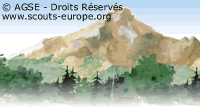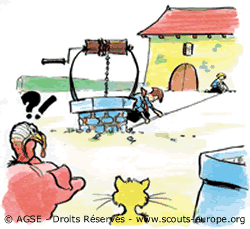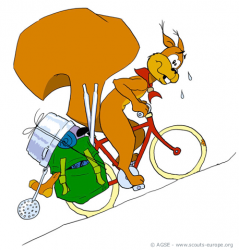Nature
 The environment (landscape, hydography, climate, the soil) can tell us many things : Why where these crops chosen ? Where does this house-shape come from ? Why do people live that way ? You can also take a look at sunshine, temperatures, soil quality (sandy, chalky, clayey...) Are there any water tables ? How are rivers distributed ? Is there a canal network ? Is there irrigation ?
The environment (landscape, hydography, climate, the soil) can tell us many things : Why where these crops chosen ? Where does this house-shape come from ? Why do people live that way ? You can also take a look at sunshine, temperatures, soil quality (sandy, chalky, clayey...) Are there any water tables ? How are rivers distributed ? Is there a canal network ? Is there irrigation ?
Which wild animals can you see in the area ? Where do they live ?(ponds, woods, meadows) Are they birds, insects, mammals ? If you are exploring a forested area, why not be on the lookout early in the morning or late at night ?
Herbariums and drawings are a good way to keep a record of the plants you saw : trees and plants can be identified when you make a pause. If you want this to be interesting you should carry guide books, that way you can be precise. Otherwise you’ll probably stay at the "I think it’s an oak" level and never progress !
Humans
 The shape of a house is often strongly linked to the climate and local customs of an area. You can find terraces, hanged roofs or flat roofs, stables, a granary ... The materials that are used show which resources are available : stone, bricks, wood, thatch, rammed earth. It can also show other problems : a fortified farm on a road of invasion for example.
The shape of a house is often strongly linked to the climate and local customs of an area. You can find terraces, hanged roofs or flat roofs, stables, a granary ... The materials that are used show which resources are available : stone, bricks, wood, thatch, rammed earth. It can also show other problems : a fortified farm on a road of invasion for example.
Churches, castles, mansions, all stand to reveal the different stages of history. You can look at the architecture, at the style and the mapping of churches, at the sculptures, paintings, stained glass windows. It is now quite common to find a brief history and a descriptive text in churches.
The tourist offices can give you maps and explanations on the area. If it’s not too expensive why not follow a guided tour of the town you’re visiting.
Economy and social life
Which crops are used ? Why is that ? What kind of stock is raised ? How are these crops harvested ? Are there any problems (epidemics, is the market good ? )
Are there any mines or quarries ? Any factories ? Have they been here for long ? How do people work there ? Who works there (men, women, farmers ) ?
Tourism, transports, the press, shops, hospitals, rest homes ... who? what ? when ? where ?
Are there any schools ? What kind of activities do they have for leisure ( sports, scouting ... ?) Does youth have to leave the area to have a good education ?
You can interview the mayor or one of his cousellors. This may point out local issues : Are the cities regrouping ? Are there any problems with sport facilities ? Is there a water problem ? Are there plans to build an incinerator ? A highway ?
What is the overview of the local history ? Does anyone famous come from the area ? What did that person do ? Did anything important occur in the area ? Where exactly ? If you run into the local scholar you can learn lots of things. Interviewing the mayor or the local teacher can also give you serious hints on what to look for in the area.
- Cultural inheritage and customs
Local feasts, legends, a specific musical instrument, such costume or song, that recipe, this piece of furniture or the local language are all quite hard to see nowadays unless you visit an area that’s proud of its traditions. If such is the case two days will surely not be enough to explore everything you want to see !


